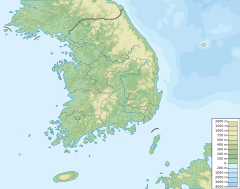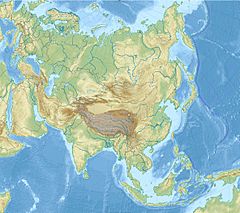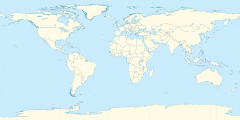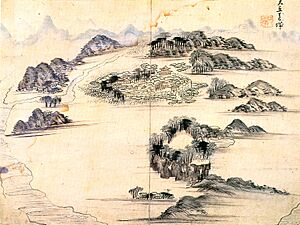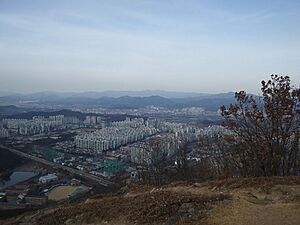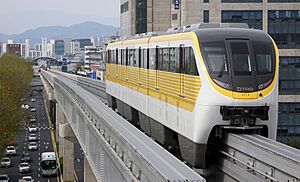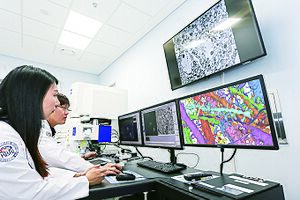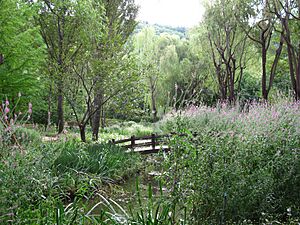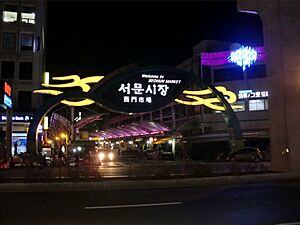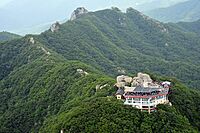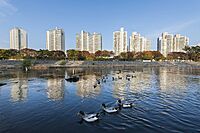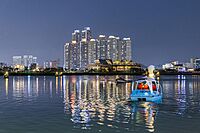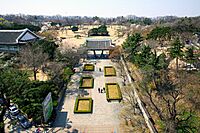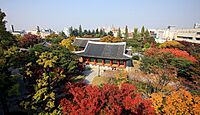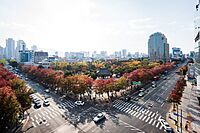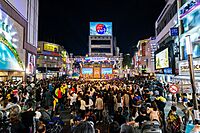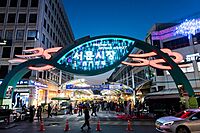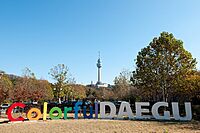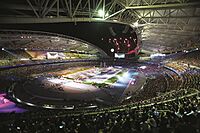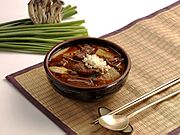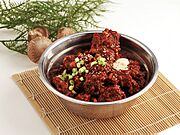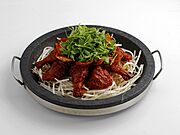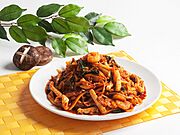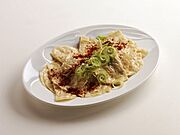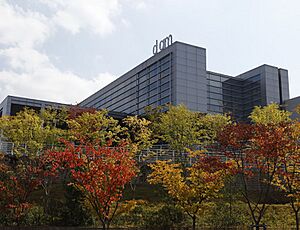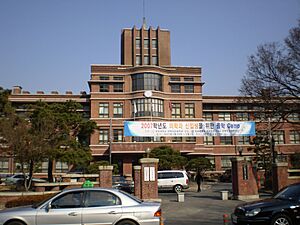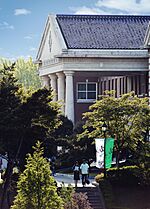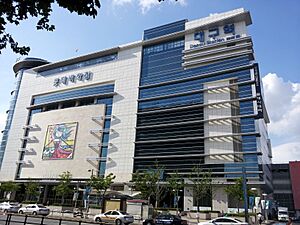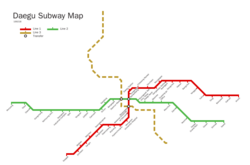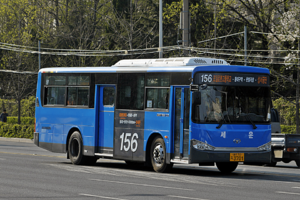Daegu facts for kids
Quick facts for kids
Daegu
대구
|
|||
|---|---|---|---|
|
Metropolitan city
|
|||
| transcription(s) | |||
| • Hangul | 대구광역시 | ||
| • Hanja | 大邱廣域市 | ||
| • Revised Romanization | Daegu-gwangyeoksi | ||
| • McCune-Reischauer | Taegu-gwangyŏksi | ||

Top: Beomeo Jct, Second: a portrait in Kim Gwangseok Street in Bangcheon Market, Daegu 83 Tower, ARC cultural center in Gangjeongbo riverside area, Bottom: Daegu Jeil Church and surrounding area, Gatbawi Statue in Gwanamsa Temple
|
|||
|
|||
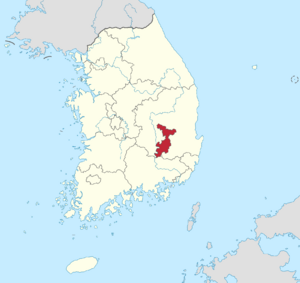 |
|||
| Country | South Korea | ||
| Region | Yeongnam | ||
| Districts | 9 districts | ||
| Government | |||
| • Type | Mayor–council | ||
| Area | |||
| • Total | 1,499.51 km2 (578.96 sq mi) | ||
| Elevation | 106 m (348 ft) | ||
| Population
(December 2023)
|
|||
| • Total | 2,374,960 | ||
| • Density | 1,583.824/km2 (4,102.085/sq mi) | ||
| • Dialect | Gyeongsang | ||
| Demonym(s) | Daeguite | ||
| GDP | |||
| • Total | KR₩ 63 trillion US$ 50 billion (2022) |
||
| Area code(s) | +82-53 | ||
| ISO 3166 code | KR-27 | ||
| Flower | Magnolia | ||
| Tree | Fir | ||
| Bird | Magpie | ||
Daegu ([tɛ̝.ɡu], Korean: 대구; Hanja: 大邱; lit. large hill), also known as Daegu Metropolitan City, is a large city in southeastern South Korea. It used to be spelled Taegu.
Daegu is the third-largest city area in South Korea, after Seoul and Busan. It is the fourth-largest metropolitan city with over 2.3 million people. It's also the second-largest city in the Yeongnam region of southeastern South Korea, after Busan. Daegu and the nearby North Gyeongsang Province are often called Daegu-Gyeongbuk, with a total population of over 5 million.
Daegu is about 80 kilometers (50 miles) from the coast. It sits near the Geumho River and the larger Nakdong River in Gyeongsang-do. The Daegu basin is a central flat area in the Yeongnam region. Long ago, the Daegu area was part of an early kingdom called Jinhan. Later, it became part of the Silla Kingdom, which united the Korean Peninsula. During the Joseon dynasty, Daegu was the capital of Gyeongsang-do, one of the country's traditional eight provinces.
Daegu was a major economic driver for Korea from the 1960s to the 1980s. It was especially known for its electronics industry. The city's warm, humid climate is perfect for growing high-quality apples, which is why it's sometimes called "Apple City." Daegu is also known as "Textile City" because textiles used to be its main industry. Today, with the Daegu-Gyeongbuk Free Economic Zone, Daegu is focusing on fashion and high-tech industries.
Daegu has hosted several big events. These include the 22nd World Energy Congress, the 2011 World Championships in Athletics, and the 2003 Summer Universiade. It also hosted four matches during the 2002 FIFA World Cup.
Contents
History of Daegu
Early Times and Ancient Kingdoms
Scientists have found many old settlements and burial sites in the Daegu area. These date back to the prehistoric Mumun pottery period (around 1500–300 BC). Some of the oldest evidence of Mumun settlements in Gyeongsangdo were found here. One important site, Dongcheon-dong, shows a large farming village from around 850–550 BC, with old houses and fields. Many large stone tombs (dolmens) have also been found.
Ancient writings tell us that during the Proto–Three Kingdoms period, Daegu was a small kingdom or walled town called Dalgubeol. It became part of the Silla kingdom by the fifth century. You can still see parts of the old wall and find relics in the modern Dalseong Park.
Silla Kingdom Era
The Silla kingdom united the Korean peninsula in the late 600s, with help from China's Tang dynasty. In 689, King Sinmun thought about moving the capital from Gyeongju to Daegu, but it didn't happen. This idea might have been to make the king's power stronger. The city got its current name in 757.
In the late 1990s, archaeologists found a large Silla fort in Dongcheon-dong. It had 39 buildings surrounded by a big ditch and fence. Experts think it might have been a military camp. They also found a large Silla village from the 6th to 7th centuries in Siji-dong.
Later Kingdoms and Goryeo Dynasty
During the Later Three Kingdoms period (892–936), Daegu first sided with Later Baekje. In 927, a big battle happened north of Daegu at Gong Mountain. Wang Kŏn's Goryeo forces fought against Kyŏn Hwŏn's Later Baekje forces. Wang Kŏn's army lost badly, and he was saved by his brave general Sin Sung-gyŏm. However, the harsh actions of Later Baekje in this battle made the local people support Wang Kŏn, who later became the king of Goryeo.
Many local names and stories still remember this battle. For example, "Ansim" means "peace of mind," and it's said to be where Wang Kŏn finally felt safe after escaping. A statue and a memorial to Sin Sung-gyŏm stand in northern Daegu today.
During the Goryeo period, the first version of the Tripitaka Koreana (Buddhist scriptures carved on woodblocks) was kept in Daegu at Buinsa temple. But it was destroyed in 1254 during the Mongol invasions of Korea.
Joseon Dynasty Period
Daegu was an important travel hub during the Joseon dynasty. It was in the middle of the Great Yeongnam Road, which connected Seoul and Busan. It also had roads leading to Gyeongju and Jinju.
In 1601, Daegu became the main administrative city of Gyeongsang-do. This large province included what is now Daegu, Busan, Ulsan, Gyeongsangbuk-do, and Gyeongsangnam-do. The city began to grow into a major center. It remained the capital for almost 300 years. In 1896, Gyeongsang-do was split into two provinces, and Daegu became the capital of Gyeongsangbuk-do.
Daegu's first regular markets started in the late Joseon period. The most famous was the Yangnyeongsi herbal medicine market. It became a big center for herbal trade, even attracting buyers from other countries. Seomun Market, located at the city's west gate, was one of the top three markets in Joseon times.
Korean Empire and Japanese Rule
In the late 1800s, Japan began to open up Korea's markets. In 1895, Daegu got one of the country's first modern post offices. This was part of the 'Gab-o' reforms after the First Sino-Japanese war.
More foreign merchants and workers started coming to Daegu in the late 1890s. The city became a modern transportation hub with the new Gyeongbu Line railroad connecting Seoul and Busan.
In 1905, the old fortress wall around Daegu was taken down. To remember it, the streets where the wall once stood are now named Bukseongno, Namseongno, Dongseongno, and Seoseongno. These names mean "north fortress street," "south fortress street," "east fortress street," and "west fortress street."
Movements for independence against foreign control grew in Daegu. One of the first was a branch of the Independence Club in 1898. As the Korean Empire was ending in 1907, local citizens, led by Seo Sang-don, started the National Debt Repayment Movement. This movement spread across the country, with many people donating money to help pay off the national debt. Protests continued after Japan took over Korea in 1910, especially during the March 1st movement of 1919. About 23,000 citizens took part in four big demonstrations in Daegu.
After 1945
In 1946, the Daegu October Incident happened. This was a serious social problem after the Republic of Korea was founded. On October 1, police killed three student protesters and hurt many others. Daegu also saw big protests on February 28, 1960, before the presidential election that year.
In the late 1940s, Daegu and North Gyeongsang province had a lot of guerrilla activity. Thousands of people moved there to escape fighting in Jeolla province. During the Korean War, there was heavy fighting near the Nakdong River. However, Daegu was inside the Pusan Perimeter, so it stayed under South Korean control throughout the war. The battle to stop North Korean troops from crossing the Nakdong River is known as the Battle of Taegu.
In the second half of the 20th century, Daegu grew very quickly. Its population increased more than tenfold after the Korean War. The city was politically favored during the 18-year rule of Park Chung Hee, as it was his political home base. Today, Daegu is known for its conservative politics and is a political base for the Saenuri Party.
In the 1980s, Daegu became a separate, self-governing city (Jikhalsi), no longer part of Gyeongsangbuk-do. In 1995, it was renamed a metropolitan city (Gwangyeoksi). Today, Daegu is the third-largest city area in Korea in terms of both population and business.
Since 1990, Daegu has experienced two of South Korea's worst disasters: the 1995 Daegu gas explosions, which killed 101 people, and the 2003 Daegu subway fire, which killed 192 people.
In February 2020, Daegu was the main area affected by the COVID-19 pandemic in South Korea.
In July 2023, Gunwi County from North Gyeongsang Province became part of Daegu.
Geography and Climate
Daegu's Landscape
Daegu is located in a basin, which is like a big bowl surrounded by low mountains. To the north is Palgongsan, to the south is Biseulsan, to the west is Waryongsan, and smaller hills are in the east. The Geumho River flows along the northern and eastern parts of the city. It then joins the Nakdong River west of Daegu.
Daegu's Weather
| Weather chart for Daegu | |||||||||||||||||||||||||||||||||||||||||||||||
|---|---|---|---|---|---|---|---|---|---|---|---|---|---|---|---|---|---|---|---|---|---|---|---|---|---|---|---|---|---|---|---|---|---|---|---|---|---|---|---|---|---|---|---|---|---|---|---|
| J | F | M | A | M | J | J | A | S | O | N | D | ||||||||||||||||||||||||||||||||||||
|
19
6
-3
|
25
9
-1
|
49
14
3
|
71
21
9
|
78
26
14
|
129
29
19
|
224
31
23
|
245
31
23
|
142
27
18
|
50
22
11
|
30
15
5
|
19
8
-1
|
||||||||||||||||||||||||||||||||||||
| temperatures in °C precipitation totals in mm |
|||||||||||||||||||||||||||||||||||||||||||||||
|
Imperial conversion
|
|||||||||||||||||||||||||||||||||||||||||||||||
Most of Daegu has a humid subtropical climate. This means it has hot, humid summers and mild winters. The mountains around the city trap hot and humid air in summer. In winter, cold air also gets trapped. The area doesn't get much rain except during the summer rainy season. It is sunny for most of the year.
Since 1961, records show that the average temperature in January (the coldest month) is 0.6°C (33.1°F). In August (the warmest month), the average is 26.4°C (79.5°F). The coldest temperature ever recorded was -20.2°C (-4.4°F), and the hottest was 40.0°C (104.0°F).
In 2014, the very hot summers led to a new nickname: "Daefrica" (Daegu + Africa). In 2015, a traffic cone in Daegu even melted from the heat! Summers in Daegu are some of the hottest in Korea. In 2023, on two different days, median strips (the raised areas in the middle of roads) melted in parts of the Suseong District due to the heat.
| Climate data for Daegu (1991–2020 normals, extremes 1907–present) | |||||||||||||
|---|---|---|---|---|---|---|---|---|---|---|---|---|---|
| Month | Jan | Feb | Mar | Apr | May | Jun | Jul | Aug | Sep | Oct | Nov | Dec | Year |
| Record high °C (°F) | 16.5 (61.7) |
24.4 (75.9) |
26.9 (80.4) |
32.0 (89.6) |
37.4 (99.3) |
38.0 (100.4) |
39.7 (103.5) |
40.0 (104.0) |
37.5 (99.5) |
31.8 (89.2) |
27.3 (81.1) |
20.8 (69.4) |
40.0 (104.0) |
| Mean daily maximum °C (°F) | 5.9 (42.6) |
8.8 (47.8) |
14.2 (57.6) |
20.6 (69.1) |
25.7 (78.3) |
28.7 (83.7) |
30.8 (87.4) |
31.3 (88.3) |
27.0 (80.6) |
22.0 (71.6) |
14.9 (58.8) |
7.9 (46.2) |
19.8 (67.6) |
| Daily mean °C (°F) | 1.1 (34.0) |
3.5 (38.3) |
8.4 (47.1) |
14.5 (58.1) |
19.7 (67.5) |
23.4 (74.1) |
26.3 (79.3) |
26.7 (80.1) |
22.1 (71.8) |
16.2 (61.2) |
9.4 (48.9) |
3.0 (37.4) |
14.5 (58.1) |
| Mean daily minimum °C (°F) | −2.9 (26.8) |
−1.1 (30.0) |
3.3 (37.9) |
8.8 (47.8) |
14.1 (57.4) |
18.8 (65.8) |
22.8 (73.0) |
23.1 (73.6) |
18.0 (64.4) |
11.4 (52.5) |
4.8 (40.6) |
−1.2 (29.8) |
10.0 (50.0) |
| Record low °C (°F) | −20.2 (−4.4) |
−16.4 (2.5) |
−10.9 (12.4) |
−6.0 (21.2) |
1.8 (35.2) |
7.8 (46.0) |
11.3 (52.3) |
12.3 (54.1) |
6.2 (43.2) |
−2.0 (28.4) |
−8.6 (16.5) |
−15.2 (4.6) |
−20.2 (−4.4) |
| Average precipitation mm (inches) | 18.6 (0.73) |
25.4 (1.00) |
49.0 (1.93) |
70.6 (2.78) |
77.9 (3.07) |
129.2 (5.09) |
223.9 (8.81) |
245.3 (9.66) |
142.4 (5.61) |
50.1 (1.97) |
29.7 (1.17) |
18.7 (0.74) |
1,080.8 (42.55) |
| Average precipitation days (≥ 0.1 mm) | 4.5 | 4.7 | 7.1 | 8.2 | 8.8 | 9.4 | 13.9 | 13.4 | 9.3 | 5.2 | 5.1 | 4.4 | 94.0 |
| Average snowy days | 4.2 | 2.2 | 1.4 | 0.1 | 0.0 | 0.0 | 0.0 | 0.0 | 0.0 | 0.0 | 0.5 | 3.0 | 11.4 |
| Average relative humidity (%) | 51.4 | 49.8 | 49.8 | 50.8 | 55.8 | 63.8 | 71.7 | 72.2 | 69.3 | 62.8 | 58.2 | 53.3 | 59.1 |
| Mean monthly sunshine hours | 195.5 | 188.6 | 210.8 | 220.2 | 232.6 | 175.1 | 153.0 | 156.6 | 164.0 | 206.2 | 183.9 | 189.4 | 2,275.9 |
| Percent possible sunshine | 62.2 | 60.3 | 54.7 | 56.1 | 52.7 | 42.1 | 34.1 | 39.5 | 43.2 | 58.1 | 58.3 | 62.7 | 50.9 |
| Average ultraviolet index | 2 | 4 | 5 | 7 | 9 | 10 | 10 | 10 | 8 | 5 | 3 | 2 | 6 |
| Source 1: Korea Meteorological Administration (percent sunshine 1981–2010) | |||||||||||||
| Source 2: Weather Atlas (UV) | |||||||||||||
The climate in Gunwi County, which joined Daegu in July 2023, is a bit different. It has colder winters than other parts of Daegu.
| Climate data for Gunwi County, Daegu (1993–2020 normals) | |||||||||||||
|---|---|---|---|---|---|---|---|---|---|---|---|---|---|
| Month | Jan | Feb | Mar | Apr | May | Jun | Jul | Aug | Sep | Oct | Nov | Dec | Year |
| Mean daily maximum °C (°F) | 4.2 (39.6) |
7.4 (45.3) |
13.5 (56.3) |
20.1 (68.2) |
25.5 (77.9) |
28.7 (83.7) |
30.5 (86.9) |
31.2 (88.2) |
26.6 (79.9) |
21.0 (69.8) |
13.5 (56.3) |
6.1 (43.0) |
19.0 (66.2) |
| Daily mean °C (°F) | −2.7 (27.1) |
0.1 (32.2) |
5.6 (42.1) |
12.0 (53.6) |
17.5 (63.5) |
21.8 (71.2) |
24.9 (76.8) |
25.2 (77.4) |
19.8 (67.6) |
12.8 (55.0) |
5.8 (42.4) |
−1.0 (30.2) |
11.8 (53.2) |
| Mean daily minimum °C (°F) | −8.6 (16.5) |
−6.4 (20.5) |
−1.5 (29.3) |
4.3 (39.7) |
10.1 (50.2) |
15.9 (60.6) |
20.6 (69.1) |
20.9 (69.6) |
15.1 (59.2) |
7.0 (44.6) |
−0.3 (31.5) |
−6.7 (19.9) |
5.9 (42.6) |
| Average precipitation mm (inches) | 14.4 (0.57) |
20.2 (0.80) |
40.5 (1.59) |
70.6 (2.78) |
74.1 (2.92) |
114.2 (4.50) |
197.5 (7.78) |
228.1 (8.98) |
133.0 (5.24) |
51.8 (2.04) |
30.2 (1.19) |
12.9 (0.51) |
987.5 (38.88) |
| Average precipitation days (≥ 0.1 mm) | 2.9 | 3.5 | 5.8 | 6.8 | 6.9 | 8.3 | 12.3 | 12.1 | 8.0 | 4.9 | 4.8 | 2.9 | 79.2 |
| Source: Korea Meteorological Administration | |||||||||||||
Daegu's Economy
Daegu is a city known for its factories and manufacturing. Its main industries are textiles, metals, and machinery. In 2021, Daegu's economy produced goods and services worth $44.144 billion. Many companies like Daegu Bank, Korea Delphi, Hwasung corp., and TaeguTec are based here. Big companies like Samsung and Kolon also started in Daegu. You can find many factories in the industrial areas on the west and north sides of the city, such as Seongseo Industrial Complex.
The city is the economic heart of the Daegu-Gyeongbuk region, which is a major industrial area in Korea. In 2006, this region was responsible for 94% of Korea's trade surplus (meaning it exported much more than it imported). The electronics factories in Gumi and the steel factories in Pohang greatly helped this surplus. Large factories for Anycall (Samsung Mobile) and POSCO are located near Daegu. In 2008, Daegu and its nearby cities were named the Daegu-Gyeongbuk Free Economic Zone by the government. This zone helps companies like Winitech, which focuses on software and manufacturing.
Historically, Daegu was a major trading center in the southern part of the Korean Peninsula. This was because of its good location. Some large, traditional markets, like Seomun Market, are still busy in the city today.
Daegu used to be the third biggest economic city in Korea, after Seoul and Busan. However, because the textile industry, which was very important to Daegu, has slowed down, the city's overall economic growth has also decreased.
Also, Daegu is the warmest region in South Korea due to its humid subtropical climate. This climate helps grow high-quality apples and oriental melons. The fruit industry is an important part of the local economy. Because of the slower economy, Daegu's population started to shrink after 2003. Recently, the local government has been working hard to boost the economy and improve the city's fashion industry.
Daegu's Fashion Industry
Since the late 1990s, Daegu has been working to grow its fashion industry. This is based on its strong history in textile and clothing manufacturing. The city promotes itself as 'Daegu: Fashion City'. It hosts many fashion and textile exhibitions every year, like the Daegu Fashion Fair and Preview in Daegu. A large new area called Esiapolis is being built in Bongmu-dong, northeastern Daegu. It aims to be a fashion hub for East Asia, with textile centers, fashion schools, international schools, and shopping malls.
Culture and Fun Things to Do
Daegu is known as a traditional city. It is one of the biggest inland cities in Korea, besides Seoul. It has become a major city area in the country. Historically, Buddhism has been strong here, and many temples still exist today. Confucianism is also popular, with a large academy in the city. You can also see many Christian churches with neon crosses on their spires.
Places to See
The most famous sight in Daegu is the stone Buddha called Gatbawi. It sits on top of Gwanbong mountain in Palgongsan. It's special because of its stone gat (a traditional Korean hat). People from all over Korea visit, believing the Buddha will grant one wish. The actual site is in the nearby city of Gyeongsan.
On the edges of the city, mountains hold many old temples like Donghwasa, Pagyesa, and Buinsa. Donghwasa is a Buddhist temple built in 493. Many old items from that time are found around it. The International Tourist Zen Meditation Center is Korea's only center focused on Zen meditation. Some old lecture halls or memorial halls, like Dodong-seowon and Nokdong-seowon, are also in the suburbs.
Old villages like Otgol village (where the Gyeongju Choi clan lived) and Inheung village (where the Nampyeong Mun clan lived) have been preserved. In the city, you can still see old Joseon dynasty buildings. These include Gyeongsang-gamyeong (an old government office) and Daegu-hyanggyo (a Confucian school). The main gate of the city from that time, Yeongnam-jeilmun (meaning "the first gateway in Yeongnam"), has been rebuilt in Mangudang Park.
Modern Western-style buildings like Gyesan Cathedral and the old Jeil Church are also preserved. Gyesan Cathedral is the third oldest Gothic church in Korea. It is the main church for the Roman Catholic Archdiocese of Daegu, one of three archdioceses in South Korea. Several buildings at the present Keisung Academy and the KNU middle/high school are also famous.
Yangnyeongsi in Namseongno (also called Yakjeon-golmok) is the oldest market for Korean medicinal herbs. It has been around for 350 years. Bongsan-dong, with its art galleries and studios, has become the city's art center since the 1990s.
Nearby places to visit include Haeinsa—a Buddhist temple that holds the Tripitaka Koreana. This is a very old and complete collection of Buddhist scriptures carved on woodblocks. Haeinsa is in Gayasan National Park in Hapcheon. The historic city of Gyeongju, the old capital of the Silla kingdom, is east of Daegu.
Mountains and Parks
Mt. Palgong, Mt. Biseul, and Mt. Ap are the main mountains in Daegu. Apsan, just south of the city, is the closest mountain to the city center. It has many walking paths, Buddhist temples, a Korean War museum, and a cable car to the top. Other mountains in the city include Waryongsan, Hamjisan, and Yongjibong. These are like local parks for citizens. Mt. Palgong also has a cable car to its peak. There are hiking trails towards Donghwasa Temple and Sutaegol Valley.
In the city area, several smaller mountains and hills also serve as parks. Dalseong Park is a historic place with a 1,500-year-old earth fortress. It has the city's only zoo and some monuments. Duryu Park is a large forest in the middle of the city. It has Daegu Tower, Woobang Land (an amusement park), and many sports facilities. Daegu Tower, also called Woobang Tower or Duryu Tower, is the tallest modern building in the city (202 meters or 663 feet tall). Its observation deck offers great views. Woobang Land is the largest amusement park outside the Seoul area. Many small gardens are in the city center, like the National Debt Repayment Movement Memorial Park (Gukchae Bosang Park) and 2·28 Park. The former park has the Dalgubeol-daejong, a large city bell that is rung every week and year. There is also a botanical garden with many different plants and flowers.
Downtown and Shopping
Dongseongno is the main downtown area of Daegu. It stretches from Daegu Station to the central police station near Banwoldang subway station. The Jung-angno subway station is close to its heart. Its name means "the street in the east fortress," as the eastern part of the old Daegu fortress was along this street. Even though Daegu is the third or fourth largest city in Korea, the Dongseongno area is the biggest downtown area in the country, except for Seoul. Many famous brands open their first store outside of Seoul here.
Other downtown areas in the city have their own unique shops and feel. The area around Seongseo Industrial Complex subway station in Dalseo-gu has many entertainment spots. Young people can often be seen around Kyungpook National University in Buk-gu. Deuran-gil in Suseong-gu is famous for its many restaurants.
The city has several department stores. Many are part of national or international chains. However, the local Daegu Department Store also has two branches, and another local chain, Donga Department Store, has four in the city. Six of these department stores are located in the downtown area. Traditional markets like Seomun Market and Chilseong Market sell all kinds of goods.
Festivals and Events
Many old traditional ceremonies and festivals from farming times have disappeared as the city modernized. A Confucian ceremony called Seokjeondaeje is still held at Daegu-hyanggyo every spring and autumn. The Yangnyeongsi herb medical festival and Otgol village festival are modern festivals that celebrate traditional culture.
Recently, people in Daegu have shown more interest in performing arts, and the local government is trying to support this. The Daegu International Opera Festival (DIOF) in October (since 2003), the Daegu International Musical Festival (DIMF), and the Daegu International Bodypainting Festival (DIBF) are three of the most famous festivals in their fields in Korea, even though they are relatively new.
Various festivals are held throughout the year by the city, different districts, or specific groups. These include the Colorful Daegu Festival, Dongseongno festival, Palgongsan maple festival, Biseulsan azalea festival, and Korea in Motion Daegu.
From August 25 to August 31, 2008, Daegu hosted the first Asian Bodypainting Festival. This was a sister event to the World Bodypainting Festival in Seeboden, Austria.
Each year, the city also hosts the Daegu International Jazz Festival: http://www.dijf.or.kr/
Every May, the "Colorful Daegu Festival" offers performances and art programs, including the Colorful Parade. In July, the Daegu Chimac Festival takes place at Duryu Park. "Chimac" is a fun word made from "chicken" and "maekju" (meaning "beer"). Over 880,000 people visited in 2015, and one million in 2016.
Daegu's 12 Famous Views
Daegu Metropolitan City has chosen 12 beautiful spots as its most scenic views. These include Palgongsan Mountain, Biseulsan Mountain, Gangjeong Goryeongbo (The Ark), Sincheon Stream, Suseongmot Lake, Dalseongtoseong Fortress, Gyeongsang Gamyeong Park, National Debt Compensation Memorial Park, Dongseongro Street, Seomun Market, 83 Tower, and Daegu Stadium.
Local Food
Daegu's food is similar to what you find in the Yeongnam region. The city is famous for some special dishes:
- Ttaro-gukbap: Daegu is the only place in Korea where people eat the rice and soup of gukbap separately.
- Mungtigi: Raw beef slices seasoned with sesame oil, garlic, and red pepper powder.
- Makchang: A dish made from beef intestines.
- Jjimgalbi: Braised beef ribs cooked in a spicy, sweet, and garlicky sauce in an aluminum pot.
- Nonmegi maeuntang: A spicy catfish stew made with kelp and radish broth.
- Bogeo bulgogi: Deboned blowfish grilled with bean sprouts in a spicy sauce.
- Muchimhoe: A salad with raw fish, squid, and vegetables in a sweet and spicy sauce.
- Yaki udon: A spicy seafood noodle dish with vegetables, similar to a dry jjamppong.
- Napjak mandu: Thin dumplings filled with small amounts of glass noodles (dangmyeon) and vegetables.
- Cuisine
Museums to Visit
- Daegu Art Museum
- Daegu National Museum – A famous national museum with old items found in and around Daegu.
- Daegu Bangjja Yugi (Korean Bronzeware) Museum
- Hengso Museum of Keimyung University
- Korea Video Museum
- Kyungpook National University Museum
- Museum for Daegu National University of Education
- Museum of Natural Dye Arts
- National Debt Repayment Movement Memorial Museum
Theaters for Shows
- Daegu Opera House – The first theater in Korea built only for opera.
- Suseong Artpia
- Keimyung Art Center – One of the biggest theaters in the city.
- Daegu Culture and Arts Center
Sports in Daegu
On March 27, 2007, Daegu was chosen to host the 2011 World Championships in Athletics. Daegu competed against cities like Moscow and Brisbane to win the votes. This event was the fourth time the championships were held outside Europe and the first time in mainland Asia. It was also the third big worldwide sports event held in Korea, after the 1988 Summer Olympics in Seoul and the 2002 FIFA World Cup (where Daegu hosted four matches). Daegu also hosted the 2003 Summer Universiade. The city hosts the Colorful Daegu Pre-Championships Meeting every year since 2005.
Daegu Stadium is the second largest sports complex in South Korea. It can hold 66,422 people. Daegu Civic Stadium hosted some football matches during the 1988 Summer Olympics.
The Daegu Marathon is held here every April. The race starts and ends at the Daegu Stadium.
Daegu Sports Teams
| Club | Sport | League | Venue | Established |
|---|---|---|---|---|
| Samsung Lions | Baseball | KBO League | Daegu Samsung Lions Park | 1982 |
| Daegu FC | Football | K League 1 | DGB Daegu Bank Park | 2003 |
| Daegu KOGAS Pegasus | Basketball | Korean Basketball League | Daegu Gymnasium | 1994 |
Samsung Lions Baseball
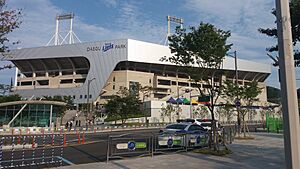
The Samsung Lions are a professional baseball team that started in 1982. They are based in Daegu and play in the KBO League. Their home stadium is Daegu Samsung Lions Park. They have won the Korean Series eight times. The Samsung Lions were the first team to win four Korean Series titles in a row (2011, 2012, 2013, and 2014). They were also the first Korean team to win the regular league title for five years in a row (2011, 2012, 2013, 2014, and 2015).
Daegu FC Football
Daegu Football Club started as a community club in late 2002. They joined the K League in 2003. Historically, Daegu has often been in the lower part of the K League standings. Their best season so far was 2021, when they finished third out of twelve teams. They also won the Korean FA Cup in 2018. This win allowed them to play in the AFC Champions League for the first time the next year. The club has also played in the AFC Champions League in 2021 and 2022.
Media and International Connections
Local Media
There are three TV stations in Daegu: KBS Daegu, Daegu MBC, and TBC. These are connected to the main TV stations in Seoul, just like other local TV companies in South Korea. TBC is linked to SBS. These stations also cover the Gyeongsangbuk-do area outside the city. Each TV company also has its own radio station.
International Daegu
Daegu is mostly a community of Korean people, with few non-Koreans. However, some immigrants from South and Southeast Asia work in car-parts factories on the west side of the city. There is also a small group of English-speaking Westerners who work in English schools and universities. Several hundred Americans live on the American military bases here. Recently, more Chinese students have started studying Korean at Daegu universities. There are also more graduate students from other Asian countries. Like in other parts of Korea, Korean food is the most common. You can also find Chinese, Japanese, and Western food, and recently, Indian and Russian foods have become available.
Daegu has three American military bases: Camp Henry, Camp George, and Camp Walker. Camp Walker has Daegu High School, while Camp George has Daegu American School for elementary and middle school students (mostly for children of military staff). Non-military employees can also enroll their children. Camp George has most of the homes for married soldiers. Camp Walker is where many officers live. Camp Henry and Camp Walker are the main work sites for military personnel.
Religion in Daegu
Religion in Daegu (2015) Not religious (55.8%) Buddhism (23.8%) Protestantism (12%) Catholicism (7.7%) Other (0.7%)
According to a 2015 study, 23.8% of people in Daegu follow Buddhism. 19.7% follow Christianity (12% Protestantism and 7.7% Catholicism). 55.8% of the population does not follow a religion.
Education in Daegu
As of 2021, Daegu has 232 elementary schools, 125 middle schools, and 94 high schools. There are two special public high schools: Daegu Science High School and Taegu Foreign Language High School. Other high schools like Keisung Academy, Gyeongsin High School, and Daeryun High School are known for helping students get into good universities. Most of the well-known high schools are in Suseong-gu, because that area has high educational standards.
Daegu also has 4 independent private high schools: Keisung Academy (also called Keisung High School), Gyeongsin High School, Gyeong-il Girl's High School, and Daegun Catholic High School.
Universities and Colleges
Daegu and its nearby towns have many private universities. Many of their main campuses are in the nearby city of Gyeongsan, which is like a college town for the Daegu area. Kyungpook National University (KNU) is one of the top-ranked national universities in Korea. It is highly rated in many subjects in the city and surrounding areas. DGIST (Daegu Gyeongbuk Institute of Science and Technology) is known as one of Korea's best universities for science and technology. DGIST is one of four special science and technology institutes in Korea. It was started in 2003. In 2019, DGIST was named one of the 'Top 25 Rising Young Universities'. Daegu has two of the most respected private universities outside Seoul: Yeungnam University (YU) and Keimyung University. There are also smaller private universities like Catholic University of Daegu and Daegu University. Daegu National University of Education trains future elementary school teachers.
Other universities and colleges include Daegu Arts University, Daegu Cyber University, Daegu Haany University, Daegu Health College, Daegu Mirae College, Daegu Polytechnic College, Daegu Technical College, Daeshin University, Kyongbuk Science College, Kyungil University, Taekyeung College, Yeungjin College, Yeungnam College of Science and Technology, and Youngnam Theological College and Seminary.
Medical Hospitals
Some large university hospitals make Daegu a medical center for southeastern Korea. The Kyungpook National University Hospital, started in 1907, is the most famous hospital in the city. The Dongsan Hospital (part of Keimyung University), started in 1899, is one of the oldest Western-style medical clinics in Korea. The Yeungnam University Medical Center has the most hospital beds in the city. These large hospitals treat the second-highest number of patients in South Korea, after Seoul. The Daegu Catholic University Medical Center is also one of these big hospitals.
Primary and Secondary Schools
- Hamji High School
- Kangbuk High School
- Maecheon High School
- Seongsan High School
International schools in Daegu include:
- Daegu International School
- Daegu Chinese Elementary School (or Korea Daeguhwagyo Elementary School)
- Overseas Chinese High School, Daegu
Daegu Sindang Elementary School
Daegu Sindang Elementary School is a public elementary school in Dalseo-gu, near Keimyung University. The school's motto is "To raise children who are upright, wise, and strong." Its symbol is the magnolia flower and the pine tree. Daegu Sindang Elementary School has a history of doing well in sports, music, and academics, winning many awards. It is also a special school for creative education and a leader in after-school programs. In 2020, students from the school won first place in the Korean National Championship of the FIRST LEGO League (FLL) robotics competition. In 2023, a student from the school won the important 12th Korea Multicultural Youth Award.
Transportation in Daegu
Trains
Daegu is a central point for train travel in Korea. The country's main train line, Gyeongbu Line, goes through the city. The biggest train station in Daegu, Dongdaegu Station, has the second-highest number of passengers in Korea, after Seoul Station. It is the station where the most trains stop in Korea. All KTX high-speed trains, Saemaul, and Mugunghwa trains stop at Dongdaegu Station.
Other trains (except KTX) leave from Daegu Station. This is a new building with cinemas, restaurants, and a department store, located near the city center. It has the tenth-highest number of passengers in Korea. The Daegu Line branches off from Gyeongbu Line at Gacheon station.
Subway System
The city also has a subway system with two main lines. Line 1 goes across the city from northeast to southwest. Line 2 goes from west to east. Line 3 is an elevated monorail that goes from northwest to southeast. All lines are run by the Daegu Metropolitan Transit Corporation (DTRO). Another line will open in a few years, using part of the Gyeongbu Line. Line 4 is a future plan for a circle line.
A subway ride costs 1400 won, or 1250 won with a special card. If you use a prepaid card, you can transfer between the subway and bus for free within an hour of your first ride.
The subway has a "Seven-color melody health donation stairs" project at Shinmae Station and Imdang Station on Line 2. When you use these stairs, LED lights turn on with keyboard sounds. Also, ₩10 (won) from each use goes to help people in need, like children with cancer or low-income families.
Roads and Buses
There are two types of buses: local and limited express. Limited express buses have more seats, but people often stand. As of 2020, a local bus ride costs about 1,400 won in cash. A limited express bus costs 1,800 won. You can get a discount if you use a prepaid card.
Bus route numbers have 3 digits. Each number shows which area the bus serves. For example, bus number 407 goes from zone four, to zone zero, and then to zone seven. Other routes, usually circular ones, are named after the districts they serve and numbered 1 to 3.
Traffic can sometimes be heavy, but the main roads usually handle a lot of cars without too much trouble.
Air Travel
Daegu is served by Daegu International Airport, located in the northeastern part of the city. As of July 2022, you can fly to international places like China, Thailand, the Philippines, and Mongolia from here.
Bus System
- Daegu Buses
Other Important Facts
Past Accidents
- The Frog Boys: This is an unsolved case from 1991 where five boys disappeared and were later found dead. People often call it "The frog boys case."
- The 1995 Daegu gas explosions killed 101 people and injured 202. A memorial was built in Haksan park to remember those who died.
- The Daegu subway fire happened on February 18, 2003. A person set fire to a train at Jungangno Station. The fire quickly spread to two trains, killing 192 people and injuring 151 others. It is the deadliest intentional loss of life in a single event in South Korea during peacetime.
Famous People from Daegu
Leaders
- Roh Tae-woo – an army general who became the thirteenth president of South Korea.
- Park Geun-hye – a former president of South Korea (from 2013 to 2017), and the daughter of former president Park Chung Hee.
Business Leaders
- Kim Woo-jung – a Korean businessman who started the Daewoo Group.
- Toni Ko – a businessperson who founded NYX Cosmetics.
- Lee Kun-hee – a South Korean businessman who was the chairman of the Samsung Group. He helped Samsung become the world's largest maker of smartphones, TVs, and memory chips.
Religious Figures
- Kim Sou-hwan – the first Korean Cardinal of the Catholic Church.
Writers
- Yi Sang-hwa – a Korean poet who wrote about resisting Japanese rule.
- Jaegwon Kim – a philosopher.
- Hyun Jin-geon – a Korean writer.
Actors and Actresses
- Bong Joon-ho – a famous director and screenwriter.
- Lee Chang-dong – a director.
- Shin Seong-il – an actor, director, and producer.
- Uhm Ji-won - an actress.
- Son Ye-jin – an actress.
- Moon Chae-won – an actress.
- Song Hye-kyo – an actress.
- Min Hyo-rin – an actress.
- Seo Ji-hoon – an actor.
- Yoo Ah-in – an actor.
- Jang Dong-yoon – an actor.
- Yoon So-ho – an actor.
- Tom Choi – an actor.
- Kim Jung-woo – an actor.
- Kim Min-jae – an actor.
- Kim Hee-sun – an actress.
- Sung Hoon – an actor.
Sports Stars
- Lee Man-Soo – a baseball player.
- Yang Jun-Hyuk – a baseball player.
- Lee Seung-Yeop – a baseball player.
- Park Chu-Young – a soccer player.
- Jin Sun-Yu – a short-track speed skater who won three gold medals at the 2006 Winter Olympics.
- Bae Sang-moon – a golfer.
- Choi Doo-ho – a mixed martial artist.
- Ji-Hwan Bae - a baseball player for the Pittsburgh Pirates.
Beauty Queens
- Chang Yun-jong – first runner-up of Miss Universe 1988, and winner of Miss Korea 1987.
- Son Tae-young – first runner-up of Miss International 2000, second runner-up of Miss Korea 2000, and an actress.
- Yoo Ye-bin – winner of Miss Korea 2013, who competed in Miss Universe 2014.
Singers
- Bae Joo-hyun (stage name Irene) – leader and member of Red Velvet.
- Choi Seung-cheol (stage name S.Coups) – leader and member of Seventeen.
- Jang Da-hye (stage name Heize) – a soloist.
- Kang Chan-hee (stage name Chani) – member of SF9.
- Kim Dong-han – former member of JBJ and member of WEi.
- Kim Ji-yeon (stage name Bona) – member of Cosmic Girls.
- Kim Ki-bum (stage name Key) – a soloist and member of Shinee.
- Kim Min-jun (stage name Jun. K) – member of 2PM.
- Kim Tae-hyung (stage name V) – a soloist, actor, and member of BTS.
- Lee Joo-heon (stage name Joohoney) – a soloist and member of Monsta X.
- Lee Seung-hyub – member of N.Flying.
- Nancy Jewel McDonie – former member of Momoland.
- Min Yoon-gi (stage names Suga and Agust D) – a soloist, songwriter, record producer, and member of BTS.
- Park Ji-young (stage name Kahi) – former leader and member of After School.
- Park So-jin – leader and member of Girl's Day.
- Charley Yang (known as BoyWithUke) – a singer, songwriter, and TikTok content creator.
Other Notable People
- Sin Sung-gyŏm – a General during the Later Three Kingdoms period.
- Kim Yong-jun – an art critic and historian.
- Jeon Tae-il – a labor activist.
Sister Cities
Daegu has special connections with these cities around the world:
 Atlanta, United States (1981)
Atlanta, United States (1981) Kyoto, Japan (1987)
Kyoto, Japan (1987) Almaty, Kazakhstan (1990)
Almaty, Kazakhstan (1990) Qingdao, China (1993)
Qingdao, China (1993) Belo Horizonte, Brazil (1994)
Belo Horizonte, Brazil (1994) Hiroshima, Japan (1997)
Hiroshima, Japan (1997) Saint Petersburg, Russia (1997)
Saint Petersburg, Russia (1997) Plovdiv, Bulgaria (2002)
Plovdiv, Bulgaria (2002) Taipei, Taiwan (2010)
Taipei, Taiwan (2010) Ningbo, China (2013)
Ningbo, China (2013) Milan, Italy (2015)
Milan, Italy (2015) Chengdu, China (2015)
Chengdu, China (2015) Milwaukee, United States (2017)
Milwaukee, United States (2017) Da Nang, Vietnam (2018)
Da Nang, Vietnam (2018)
Friendship Cities
Daegu also has friendship agreements with these cities:
 Yangzhou, Jiangsu, China (2003)
Yangzhou, Jiangsu, China (2003) Yancheng, Jiangsu, China (2003)
Yancheng, Jiangsu, China (2003) Shenyang, Liaoning, China (2003)
Shenyang, Liaoning, China (2003) Kobe, Hyōgo, Japan (2010)
Kobe, Hyōgo, Japan (2010) Ho Chi Minh City, Vietnam (2015)
Ho Chi Minh City, Vietnam (2015) Shaoxing, Zhejiang, China (2015)
Shaoxing, Zhejiang, China (2015) Wuhan, Hubei, China (2016)
Wuhan, Hubei, China (2016) Bangkok, Thailand (2017)
Bangkok, Thailand (2017) Changsha, Hunan, China (2018)
Changsha, Hunan, China (2018) Kaohsiung, Taiwan (2018)
Kaohsiung, Taiwan (2018) Bắc Ninh Province, Vietnam (2019)
Bắc Ninh Province, Vietnam (2019) Lille, France (2019)
Lille, France (2019) Yanbian, China (2021)
Yanbian, China (2021) Bukhara, Uzbekistan (2022)
Bukhara, Uzbekistan (2022) Johor Bahru, Malaysia (2023)
Johor Bahru, Malaysia (2023)
See also
 In Spanish: Daegu para niños
In Spanish: Daegu para niños




